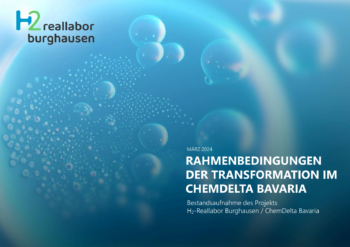Series of articles concerning hydrogen: History of hydrogen
Everyone is talking about hydrogen at least since the national hydrogen strategy was adopted. Also at FfE, research is being conducted into the contribution of hydrogen to the future energy system. Current projects focus on the sustainable production, transport and use of hydrogen as well as on overarching issues of market development and business models.
This article is the first in a series of six articles that will be published successively in the coming weeks. In this series of articles, the most important aspects of hydrogen will be explained briefly, comprehensibly and compactly.
Overview of the topics in the series of articles on hydrogen
- History of hydrogen as an energy carrier
- How is hydrogen produced?
- Where will hydrogen be used?
- How is hydrogen transported?
- What contribution can hydrogen make to the energy transition?
- Overview of current hydrogen projects
Hydrogen as the energy carrier of the future
Currently, national hydrogen strategies are being adopted and large hydrogen projects are being announced in many countries around the world. However, the vision of hydrogen as the “energy carrier of the future” is already about 150 years old and has gone through several cycles of illusion and disillusion. In this article, we would like to give an overview of the historical developments in the field of hydrogen.
Basics of hydrogen technology
After hydrogen was discovered as an element by the Briton Cavendish in 1766, the technical foundations of hydrogen technology were already laid in the 19th century: in 1800, the principle of water electrolysis was discovered, in which water is broken down into oxygen and hydrogen when voltage is applied. The principle of the fuel cell, which allows the energy stored in hydrogen to be converted into electricity, was discovered in 1838. However, the fuel cell could not prevail over the generators powered by steam engines, which were developed at the same time. [1]

Early hydrogen visions
Visions of a hydrogen-based energy system, however, existed early on. Jules Verne described hydrogen as the coal of the future in his book “The Mysterious Island” as early as 1874:
“…with water decomposed by electric current […] hydrogen and oxygen, we shall secure the energy supply of the earth for an unforeseeable time. One day, steamships and locomotives will no longer carry coal bunkers, but gas tanks from which compressed gases will flow through pipes into the boilers. Water is the coal of the future. …”
Jules Verne’s vision already envisioned the generation of hydrogen by electricity, but did not answer the question of how this electricity would be generated. [2]
First wind power electrolyzer
The question of the possible origin of electricity was answered as early as 1895 by the “pioneer of wind energy,” Poul le Cour, not only theoretically but also practically. In 1895, he set up an experimental plant in Denmark with one of the world’s first wind turbines for generating electricity. To solve the problem of the wind turbine’s variable generation over time, he also envisaged storing the wind energy in the form of hydrogen. This plant ran for seven years. The hydrogen generated and stored was used directly in gas lights at a nearby community college. [2]
Hydrogen for fertilizer production
At the beginning of the 20th century, the non-energetic use of hydrogen gained importance. The Germans Bosch and Haber developed a process for the industrial synthetic production of ammonia from hydrogen and nitrogen. Both scientists were awarded the Nobel Prize for this. Ammonia is an important basic chemical substance that is needed in particular for fertilizers and thus made population growth possible. Electrolysers of the time could not produce the industrial quantities of hydrogen needed, so processes of coal gasification were resorted to. Even today, much of the hydrogen produced is used for ammonia synthesis rather than for energy use. [3]
First application of fuel cells in space travel
The first practical applications for generating electricity from hydrogen were in space travel. For NASA’s space programs in the mid-20th century, not only was hydrogen used to fuel the rockets, but the spacecraft of the Gemini and Apollo missions also carried fuel cells to supply electricity, heat and drinking water on board. The advantage of hydrogen in spaceflight was especially its low weight, while cost did not play a major role. Important advancements in hydrogen fuel cell and storage technology were undertaken during these missions. [1]
Search for alternatives to oil
In the wake of the oil crises in the 1970s, alternatives to fossil energy yields were sought and the concept of a hydrogen economy was developed, with hydrogen playing a central role as an energy carrier. Large research projects were carried out, especially in the U.S. and Europe, the first scientific journals were founded, and conferences were held with the theme of the hydrogen economy. [1,4]
Solar hydrogen
In the 1980s, the first demonstration projects for solar hydrogen were presented, which received worldwide attention. One was the German-Saudi Arabian project HYSOLAR, another the solar hydrogen project near Neuenburg in Bavaria. In both projects, electricity from photovoltaic systems fed the electrolysers. They showed that a hydrogen economy was technically possible. However, the high costs continued to be a very big hurdle. [5]
Fuel cells and mobility
In the 1990s and 2000s, research made great progress in the mobile application of hydrogen and fuel cells. The auto industry made great efforts to develop hydrogen-powered fuel cell cars. Prototypes of hydrogen-powered fuel cell vehicles such as passenger cars and buses were introduced, and their technical suitability was proven in worldwide fleet trials. However, the problems of high cost compared to conventional vehicles as well as the lack of a refueling infrastructure remained. [1,5,6]
Hydrogen as part of the energy transition
The 2010s were marked by the goal of climate neutrality and limiting global warming to 1.5 degrees. (Hydrogen Council). Thanks to significantly lower costs of renewable energies, their share in the power sector increased worldwide. However, complete decarbonization of the energy sector requires emission reductions in all sectors, including sectors that are difficult to decarbonize, such as industry. Here, hydrogen, with its multiple applications, offers the potential to support the achievement of climate targets through better integration of renewables. [6,7]
Hydrogen strategies and market ramp-up
As a contribution to achieving climate goals, more than 20 countries have already adopted hydrogen strategies and roadmaps. In Germany, the hydrogen strategy adopted in 2020 envisions annual production of 14 TWh of hydrogen by 2030. Countries worldwide are providing more than USD 70 billion to enable a market ramp-up. In Germany, this is being done, among other things, in the so-called “Reallaboren der Energiewende” (real laboratories of the energy turnaround) where hydrogen technologies close to the market are being promoted on an industrial scale. [7,8]
Barely 150 years after Jules Verne’s first hydrogen visions, much has happened in the world of hydrogen, but surprisingly little has changed in the fundamental concepts of the energetic use of hydrogen. Nonetheless, it seems that now commitments to meet climate goals by companies and governments are leading to the adoption of hydrogen in many areas. Research must accompany this process so that the contribution of hydrogen to achieving the goals can be verified and possibilities for control can be identified.
Further information:
- Trans4ReaL – Transferforschung für die Reallabore der Energiewende zu Sektorkopplung und Wasserstoff
- Warum reden alle über Wasserstoff? – Interview mit Prof. Dr.-Ing. Ulrich Wagner
- Elektrolyse – Die Schlüsseltechnologie für Power-to-X
Literature:
[1] J. Adolf, M. Fischedick, Shell Wasserstoff-Studie Energie der Zukunft?: Nachhaltige Mobilität durch Brennstoffzelle und H2, 2017.
[2] K. Schönleber, Wasserstoffwirtschaft –Ein flüchtiger Traum?, Kultur & Technik – das Magazin aus dem Deutschen Museum (2020).
[3] C. Flavell-While, Fritz Haber and Carl Bosch – Feed the World, 2010. https://www.thechemicalengineer.com/features/cewctw-fritz-haber-and-carl-bosch-feed-the-world/ (accessed 30 April 2021).
[4] International Renewable Energy Agency, Green hydrogen: A guide to policy making.
[5] Bundesministerium für Wirtschaft und Arbeit, Strategiepapier zum Forschungsbedarf in der Wasserstoff-Energietechnologie, 2005.
[6] J. Töpler, J. Lehmann, Wasserstoff und Brennstoffzelle, Springer Berlin Heidelberg, Berlin, Heidelberg, 2017.
[7] Hydrogen Insights: A perspective on hydrogen investment, market development and cost competitiveness, 2021.
[8] BMWi, Nationales Reformprogramm 2020 – Die Nationale Wasserstoffstrategie, 2020.

